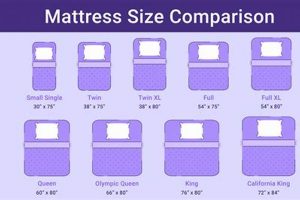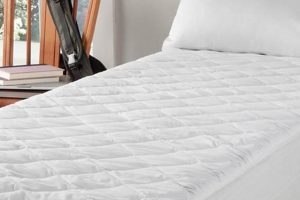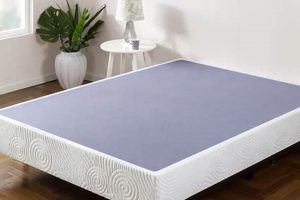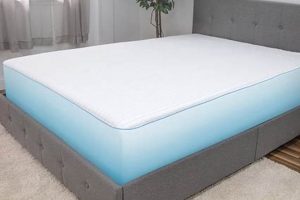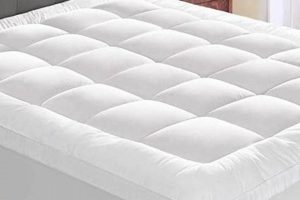A Twin XL mattress, often encountered in college dormitories and guest rooms, presents a specific set of dimensions. This size typically measures 38 inches in width and 80 inches in length. These measurements distinguish it from a standard twin mattress, which maintains the same width but is shorter in length. A practical application of these dimensions allows for taller individuals to sleep comfortably without extending beyond the mattress’s edge.
The extended length of this mattress provides a significant benefit for taller individuals who require additional legroom. The utilization of this mattress is often favored in environments where space is a premium, but accommodation for varying heights is necessary. Its origin stems from the need to cater to the growing height of young adults entering higher education, ensuring adequate sleep support in smaller dormitory settings.
Understanding the dimensions provides a foundational knowledge. Subsequent sections will delve into comparative mattress sizes, optimal room dimensions for placement, and the availability of complementary bedding accessories, offering a thorough understanding of its practical applications and purchasing considerations.
Guidelines for Selecting a Twin XL Mattress
The subsequent guidelines provide insights into selecting a Twin XL mattress, considering various factors that contribute to overall sleep quality and suitability within a given space.
Tip 1: Measure the Intended Space: Before acquisition, precisely measure the room where the Twin XL mattress will be placed. The dimensions, 38 inches by 80 inches, must accommodate furniture and allow for comfortable movement.
Tip 2: Consider Sleeper Height: The 80-inch length is specifically designed for taller individuals. Evaluate the height of the intended user to ensure adequate leg support and prevent discomfort.
Tip 3: Evaluate Mattress Type: Twin XL mattresses are available in various constructions, including innerspring, memory foam, and hybrid models. Each type offers different levels of support, firmness, and temperature regulation; research each to determine the best fit for individual needs.
Tip 4: Examine Edge Support: If the user tends to sleep near the edge of the mattress, ensure that the chosen model provides adequate edge support to prevent sagging and improve stability.
Tip 5: Assess Bed Frame Compatibility: Verify that the existing or planned bed frame is specifically designed to accommodate a Twin XL mattress. Using an incompatible frame may void warranties or compromise support.
Tip 6: Research Bedding Options: Acquire Twin XL-specific bedding, including sheets, comforters, and mattress protectors. Standard twin bedding will not adequately fit the longer dimensions of the Twin XL.
Tip 7: Check Warranty and Return Policies: Prior to purchase, meticulously review the manufacturer’s warranty and the retailer’s return policy. This provides recourse in case of defects or dissatisfaction with the mattress.
Adhering to these guidelines can facilitate an informed purchasing decision, ensuring that the selected Twin XL mattress optimally meets individual requirements and spatial constraints.
The following sections will discuss additional factors, such as cost considerations and care instructions, to further enhance the user’s understanding of Twin XL mattresses.
1. Width
The width, a critical dimension, defines the lateral extent of the Twin XL mattress. The standardized width measurement is 38 inches. This dimension directly influences the number of individuals who can comfortably occupy the sleeping surface. A narrow width is inherent to the design, making it optimal for single sleepers and environments where space conservation is prioritized, such as dormitories and smaller guest rooms. A larger width would preclude its usability in these confined spaces.
The defined width creates a correlation between occupant size and comfort. The 38-inch width can adequately accommodate a single adult of average build. However, individuals with broader physiques may experience a sense of constraint. This constraint can lead to disrupted sleep patterns due to restricted movement. The fixed width, therefore, dictates the mattress’s suitability for specific body types and sleep preferences. Bedding manufacturers also tailor sheet sets and mattress protectors to precisely fit this standard width, ensuring a secure and aesthetically pleasing fit.
Therefore, the 38-inch width is a defining characteristic that governs its application in space-constrained settings and its suitability for individual sleepers. Variations from this standard would fundamentally alter the mattress’s purpose and target demographic. Careful consideration of this width is essential to guarantee adequate comfort and optimized space utilization.
2. Length
Length, a defining attribute of the Twin XL mattress, constitutes the longitudinal dimension and directly contributes to the overall size. Standardized at 80 inches, the length distinguishes it from a standard twin mattress, which typically measures 75 inches. This additional length is not arbitrary; it serves a specific purpose in accommodating taller individuals, generally those exceeding six feet in height. Without the extended length, taller sleepers would experience discomfort due to their feet extending beyond the mattress edge. The resulting lack of proper spinal alignment can lead to disrupted sleep and long-term musculoskeletal issues. An example is seen in college dormitories, where the Twin XL is prevalent precisely to cater to the height of young adults.
The practical significance of the 80-inch length extends beyond mere comfort. It directly affects the quality of sleep and, consequently, overall health. Insufficient leg support results in pressure points and can impede circulation. A properly supported spine, facilitated by adequate mattress length, promotes natural sleep posture and reduces the likelihood of back pain. Further, the length influences the selection of appropriate bedding. Standard twin-sized sheets are incompatible with the Twin XL due to the dimensional difference, requiring specific Twin XL-sized linens to ensure a proper fit and prevent slippage during sleep.
In summation, the 80-inch length is an integral component of the Twin XL size, directly impacting sleeper comfort, spinal alignment, and bedding compatibility. Its presence addresses the needs of a specific demographic taller individuals thereby ensuring that the mattress serves its intended purpose effectively. Understanding the importance of this length dimension is crucial for informed purchasing decisions and optimal sleep health.
3. Thickness
Thickness, while not directly determining the length and width, is an essential dimensional component that contributes to the overall size perception and functionality of a Twin XL mattress. Thickness, generally measured in inches, dictates the vertical profile of the mattress and influences factors such as support, comfort, and ease of entry/exit. A thinner mattress, for instance, might be less supportive for heavier individuals, leading to discomfort and potential back pain. Conversely, an excessively thick mattress could elevate the sleeping surface to an uncomfortable height, making it difficult to get in and out of bed. The selection of an appropriate thickness should therefore correlate with the sleeper’s weight, physical abilities, and bed frame height.
The interplay between thickness and the other dimensions manifests in several practical ways. For instance, the perceived volume of a Twin XL mattress, which contributes to how much space it visually occupies in a room, is significantly affected by its thickness. A thicker mattress will appear more substantial, while a thinner mattress will seem less obtrusive. Moreover, the thickness can impact the choice of bed frame. Platform beds, which typically sit lower to the ground, often pair well with thicker mattresses, while adjustable bed frames may have limitations on the maximum mattress thickness they can accommodate. Additionally, bedding manufacturers often specify a range of acceptable mattress thicknesses for their fitted sheets, underscoring the importance of considering this dimension when purchasing complementary items.
In conclusion, while the primary determining factors for the size are length and width, thickness functions as a crucial third dimension that modulates the overall sleeping experience and space utilization. Selecting an appropriate thickness, in conjunction with the standard Twin XL dimensions, ensures optimal comfort, support, and compatibility with existing bedroom furniture and accessories. Overlooking the thickness dimension can lead to suboptimal sleep quality and practical inconveniences, highlighting its significance in the comprehensive assessment of a Twin XL mattress.
4. Surface Area
Surface area, a derived metric, represents the two-dimensional expanse of the sleepable surface. It is calculated by multiplying the mattress’s width by its length and is a key indicator of the space available to the occupant. The surface area of a Twin XL directly correlates to the comfort and movement range afforded to a single sleeper.
- Calculation and Significance
The surface area is determined by multiplying the width (38 inches) by the length (80 inches), resulting in 3,040 square inches. This figure quantitatively represents the area available for sleeping, directly impacting the sleeper’s ability to change positions and maintain a comfortable posture. Smaller individuals may find this surface area ample, while those who are restless sleepers or require more room to stretch out may find it restrictive.
- Comparison with Other Mattress Sizes
Comparing the surface area of the Twin XL to other mattress sizes provides context. A standard twin mattress, with a length of 75 inches, offers a smaller surface area (2,850 square inches). A full-size mattress (54 inches x 75 inches) offers a larger surface area (4,050 square inches), and a queen-size (60 inches x 80 inches) offers an even greater area (4,800 square inches). These comparisons demonstrate how surface area scales with mattress size, each catering to differing needs and preferences.
- Impact on Bedding Selection
The surface area influences the selection of appropriate bedding. The dimensions of sheets, blankets, and mattress protectors must adequately cover the entire surface to ensure a secure fit and prevent discomfort. Standard twin bedding is not suitable for the Twin XL due to the length discrepancy, requiring specific Twin XL-sized linens. Failure to use appropriately sized bedding can lead to slippage, bunching, and reduced sleep quality.
- Influence on Room Layout
The surface area contributes to the overall footprint of the Twin XL mattress within a room. In smaller spaces, such as dormitories, the dimensions and calculated surface area must be considered when planning the layout. A larger surface area implies a greater spatial commitment. Proper measurement and space planning are essential to ensure that the mattress fits comfortably within the room without impeding movement or functionality.
The calculated surface area is an important consideration for assessing the suitability of a Twin XL mattress for individual needs, bedding options, and space constraints. Variations in the dimensions that calculate the surface area directly impact the overall sleeping experience, highlighting the importance of considering the size when making a purchase decision. Understanding surface area provides valuable insight for optimizing comfort and functionality.
5. Frame Compatibility
The term ‘Frame Compatibility’ denotes the degree to which a bed frame corresponds dimensionally with a specific mattress size. For the Twin XL mattress, adherence to standardized dimensions is paramount for structural integrity and sleeper safety. Incompatibility can lead to reduced support, premature mattress wear, and potential instability, negating the benefits derived from the specific size.
- Standardized Dimensions and Support
Twin XL mattresses are standardized at 38 inches wide and 80 inches long. A compatible frame must precisely match these measurements to provide uniform support across the mattress surface. Insufficient support, often resulting from the use of a smaller or ill-fitting frame, causes uneven weight distribution, leading to sagging and diminished comfort. An appropriate frame ensures that the mattress rests securely, preventing movement and maintaining its intended shape.
- Bed Frame Types and Suitability
Various bed frame types exist, including platform beds, slat systems, and adjustable bases. Each frame type presents unique compatibility considerations. Platform beds typically offer solid, continuous support, whereas slat systems require appropriately spaced and robust slats to prevent sagging. Adjustable bases must be specifically designed to accommodate the Twin XL dimensions and the mattress’s thickness. Deviations from these requirements can compromise the mattress’s performance and longevity.
- Impact on Warranty and Mattress Lifespan
Manufacturers often stipulate frame requirements within mattress warranties. The use of an incompatible frame may void the warranty, leaving the consumer responsible for repair or replacement costs. Further, inadequate support accelerates mattress wear, shortening its lifespan and reducing its overall value. Selecting a compatible frame is therefore a critical investment that safeguards both the mattress and the warranty.
- Safety Implications
An improperly supported Twin XL mattress poses potential safety risks. Instability can lead to the mattress shifting or falling off the frame, potentially causing injury to the sleeper. A secure and appropriately sized frame mitigates this risk, providing a stable and safe sleeping environment. Ensuring frame compatibility is therefore an essential safety precaution.
In summation, frame compatibility is inextricably linked to the optimal performance and longevity. Adherence to the specified dimensions is paramount for providing adequate support, preserving warranty coverage, and ensuring user safety. Prioritizing frame compatibility ensures that the investment in a Twin XL mattress yields the intended benefits, optimizing sleep quality and maximizing the mattress’s lifespan.
6. Room Dimensions
Room dimensions dictate the suitability of a Twin XL mattress within a given space. The interaction between the mattress size and the available square footage significantly impacts room functionality, aesthetics, and occupant comfort. Optimizing the layout requires a careful assessment of space constraints and potential obstructions.
- Minimum Room Size
The minimum room size to comfortably accommodate a Twin XL mattress, measuring 38 inches by 80 inches, is approximately 7 feet by 9 feet. This calculation accounts for the mattress dimensions while allowing for basic circulation around the bed. A room smaller than this minimum may feel cramped and restrict movement. In dormitories, where space is at a premium, these minimum dimensions are frequently encountered.
- Furniture Placement and Clearance
Effective furniture placement requires considering the clearance around the Twin XL mattress. A minimum of 2 feet of open space should be maintained on at least one side of the bed to facilitate easy access and egress. Additional clearance may be necessary to accommodate bedside tables, desks, or other furniture. Poor furniture placement can impede traffic flow and diminish the usability of the room. For example, placing a desk directly at the foot of the bed without sufficient clearance will obstruct access and create a confined feeling.
- Door Swing and Entry Points
The swing of the room’s door and the location of entry points are critical considerations. The door should not collide with the Twin XL mattress when opened, nor should the bed obstruct the primary entry path. A door that swings inward necessitates careful placement to avoid impacting the mattress or other furniture. Altering the door swing or relocating the entry point can mitigate potential conflicts and optimize room functionality. Failure to consider the door swing may necessitate rearranging the entire room layout.
- Window Placement and Natural Light
Window placement and the availability of natural light should inform the placement of the Twin XL mattress. Positioning the bed directly beneath a window may expose the occupant to drafts or excessive sunlight, potentially disrupting sleep. Orienting the bed to maximize natural light exposure without causing glare or overheating is essential for creating a comfortable and functional sleeping environment. Blocking a window with the bed will reduce natural light and hinder ventilation.
The interplay between room dimensions and the size underscores the importance of careful planning. Considering minimum room size, furniture placement, door swing, and window placement ensures that the mattress integrates seamlessly into the space, optimizing both functionality and comfort. Neglecting these aspects can result in a cramped, inefficient, and aesthetically unappealing environment.
7. Weight
The weight of a Twin XL mattress is a relevant consideration intricately tied to its dimensions and construction. It influences portability, ease of handling, and the capacity of supporting bed frames. Understanding these weight-related factors informs purchasing decisions and optimizes the practical use of the mattress.
- Material Composition and Density
The materials used in construction directly impact the overall weight. Innerspring mattresses tend to be heavier due to the steel coil system, while memory foam mattresses vary depending on foam density. Hybrid models, incorporating both coil and foam layers, occupy a mid-range weight spectrum. Higher density materials translate to increased support and durability but also contribute to a heavier final product. For instance, a high-density memory foam Twin XL can weigh significantly more than a low-density foam or innerspring model of the same dimensions.
- Impact on Portability and Setup
A mattress’s weight affects its portability during initial setup and subsequent relocation. Lighter mattresses are easier to maneuver and position on the bed frame, reducing the physical strain during installation. Conversely, heavier mattresses may require two or more individuals for safe handling. In scenarios such as dorm room move-ins or apartment relocations, a lighter mattress simplifies the process and minimizes the risk of injury. A heavier mattress might necessitate professional assistance for movement, adding to the overall cost.
- Bed Frame Load Capacity
The weight of the mattress must be compatible with the load-bearing capacity of the bed frame. Exceeding the frame’s weight limit can compromise structural integrity, leading to sagging, damage, or even complete failure. Platform beds and adjustable bases often have specific weight restrictions. Carefully assessing the frame’s stated capacity and comparing it to the mattress’s weight is critical for preventing damage and ensuring long-term stability. Reinforcing the frame may become essential if a heavier mattress is selected.
- Effect on Mattress Lifespan and Support
The weight of the sleeper, combined with the mattress’s own weight, exerts continuous pressure on its internal components. Over time, this pressure can lead to compression and degradation of the support layers, particularly in lower-quality mattresses. Higher-density materials generally withstand compression more effectively, extending the mattress’s lifespan. Weight distribution and support are crucial for maintaining comfort and preventing the formation of pressure points. A lighter person may not experience the same level of support and contouring as a heavier individual on the same mattress due to differences in compression.
In conclusion, a Twin XL mattress’s weight influences several practical considerations, from ease of handling and setup to bed frame compatibility and long-term support. Understanding these weight-related factors enables consumers to make informed decisions, ensuring that the selected mattress aligns with their physical capabilities, bed frame limitations, and desired level of support and durability. This understanding optimizes both the short-term convenience and long-term performance of the sleep setup.
Frequently Asked Questions
The following questions address common inquiries regarding the dimensions and characteristics of the Twin XL mattress, providing clarity and facilitating informed decision-making.
Question 1: Is the size of a Twin XL mattress consistent across all manufacturers?
While standardized dimensions exist (38 inches wide by 80 inches long), minor variations (typically within an inch) may occur due to manufacturing tolerances. Always verify the exact dimensions with the retailer or manufacturer before purchasing bedding.
Question 2: How does the size of a Twin XL mattress compare to that of a standard full-size mattress?
A Twin XL mattress is narrower (38 inches vs. 54 inches) but longer (80 inches vs. 75 inches) than a standard full-size mattress. The Twin XL is designed for single sleepers requiring additional length, while the full-size provides more width for single sleepers or occasional use by two individuals.
Question 3: What is the ideal room size for a Twin XL mattress to ensure adequate space and maneuverability?
The minimum recommended room size for comfortably accommodating the mattress is approximately 7 feet by 9 feet. This allows for basic circulation and furniture placement. Smaller rooms may feel cramped, and larger rooms offer greater flexibility in layout.
Question 4: Are Twin XL mattresses suitable for adjustable bed frames?
Yes, provided the adjustable bed frame is specifically designed to support Twin XL dimensions and the mattress’s thickness. Verify compatibility specifications with both the mattress and frame manufacturers before purchase to prevent damage or voiding warranties.
Question 5: Does the thickness of a Twin XL mattress influence the required depth of fitted sheets?
Yes. Deeper mattresses necessitate fitted sheets with corresponding pocket depths. Measure the mattress thickness accurately and select sheets accordingly to ensure a secure and proper fit, preventing slippage and discomfort.
Question 6: How does the weight of a Twin XL mattress impact the selection of a supporting bed frame?
The bed frame must possess a load-bearing capacity sufficient to support the combined weight of the mattress and the sleeper(s). Exceeding the frame’s weight limit can compromise its structural integrity, leading to sagging or failure. Consult the frame manufacturer’s specifications before selection.
Understanding these size-related aspects is fundamental for ensuring a comfortable and functional sleep environment, optimizing both the user experience and the longevity of the mattress.
Subsequent discussions will address the various types of Twin XL mattresses available and their respective advantages and disadvantages.
Conclusion
The preceding sections have comprehensively detailed how big is a twin xl mattress, addressing its dimensions, spatial implications, and relevant purchasing considerations. From length and width to thickness and weight, each dimensional aspect influences comfort, functionality, and compatibility with supporting structures. A clear understanding of these specifications facilitates informed decision-making.
The knowledge of how big is a twin xl mattress allows for optimized space utilization and informed selection of appropriate bedding and bed frames. Continued adherence to standardized dimensions and a thorough assessment of individual needs ensures optimal sleep quality and long-term satisfaction with the chosen sleep solution. Further research into material composition and construction techniques can further enhance the user’s understanding and appreciation of this prevalent mattress size.


